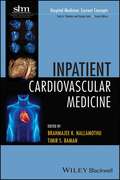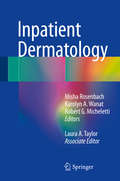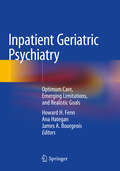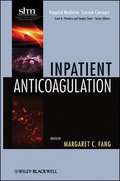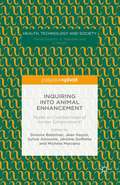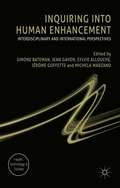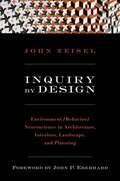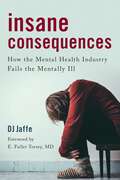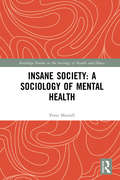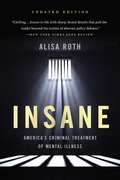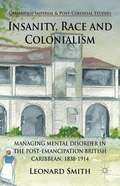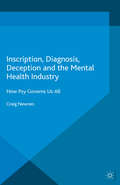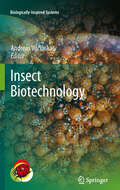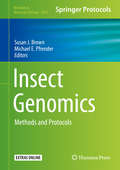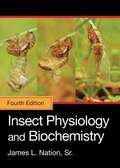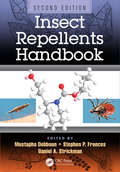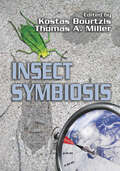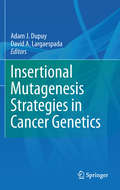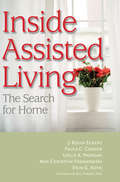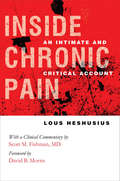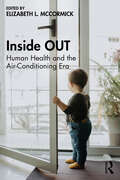- Table View
- List View
Inpatient Cardiovascular Medicine
by Timir S. Baman Brahmajee K. NallamothuThe first book developed specifically for hospitalists managing the growing number of patients with cardiovascular disordersCardiovascular disease is a major cause of hospitalization and mortality worldwide, and will account for approximately twenty million deaths in 2015. Due to this growing problem, many patients are being managed by non-cardiovascular physicians in the inpatient setting. As a result, hospitalists and other inpatient physicians without specialized training in cardiology are faced with uncertainty when contemplating the proper management of these patients.This book focuses on inpatient cardiovascular medicine in a highly algorithmic and evidence-based approach, so that users will be able to care for their hospitalized patients directly, using the best contemporary evidence available. It emphasizes the practical, immediate application of principles and treatment recommendations into everyday clinical inpatient practice, while simplifying the approach to these patients by utilizing visual aids such as carefully designed charts, illustrations, and diagrams.Inpatient Cardiovascular Medicine features thoughtful, comprehensive coverage by top experts in the field. Topics include:Cardiovascular History and Physical ExaminationIntroduction to ElectrocardiographyNon-invasive Cardiac Imaging Cardiac Stress Testing and the Evaluation of Chest PainPerioperative Cardiac Evaluation Cardiac ResuscitationAcute Coronary Syndromes: Unstable Angina and Non-ST Elevation Myocardial InfarctionAcute ST-Elevation Myocardial InfarctionChronic Coronary Artery DiseasePeripheral Arterial DiseaseThoracic Aortic DiseaseSystolic Heart FailureDiastolic Heart FailureDilated and Restrictive CardiomyopathyHypertrophic CardiomyopathyHeart Transplantation and Left Ventricular Assist DevicesSyncopeApproach to the Patient with a Narrow Complex TachycardiaApproach to the Patient with a Wide Complex TachycardiaAtrial Fibrillation and Atrial FlutterAntiarrhythmic Drug TherapyCardiac Pacemakers and Implantable DefibrillatorsValvular Heart DiseaseInfective EndocarditisPericardial DiseasesPulmonary HypertensionCardiac Tumors
Inpatient Dermatology: Caring For Dermatologic Issues In Hospitalized Patients
by Misha Rosenbach Karolyn A. Wanat Robert G. Micheletti Laura A. Taylor Inpatient Dermatology is a concise and portable resource that synthesizes the most essential material to help physicians with recognition, differential diagnosis, work-up, and treatment of dermatologic issues in the hospitalized patient. Complete with hundreds of clinical and pathologic images, this volume is both an inpatient dermatology atlas and a practical guide to day-one, initial work-up, and management plan for common and rare skin diseases that occur in the inpatient setting. Each chapter is a bulleted, easy-to-read reference that focuses on one specific inpatient dermatologic condition, with carefully curated clinical photographs and corresponding histopathologic images to aid readers in developing clinical-pathologic correlation for the dermatologic diseases encountered in the hospital. Before each subsection the editors share diagnostic pearls, explaining their approach to these challenging conditions. This book is structured to be useful to physicians, residents, and medical students. It spans dermatology, emergency medicine, internal medicine, infectious disease, and rheumatology. Inpatient Dermatology is the go-to guide for hospital-based skin diseases, making even the most complex inpatient dermatologic issues approachable and understandable for any clinician.
Inpatient Geriatric Psychiatry: Optimum Care, Emerging Limitations, and Realistic Goals
by James A. Bourgeois Ana Hategan Howard H. FennThis book offers mental health guidelines for all medical professionals facing the emerging challenges presented by an aging population worldwide. The text acknowledges that as the geriatric demographic grows, limited resources and infrastructures demand quality protocols to deliver inpatient geriatric psychiatric care, and that many physicians may not be trained to address these specific needs. This text fills this gap with guidelines assessing, diagnosing, and treating aging patients as they present in the emergency room and other settings. Unlike any other text, this book focuses on how to optimize the use of the inpatient setting by recommending evaluations and treatments, and offering flow-charts and figures of key points, to guide both general workup and continued evaluation and treatment. This approach aims to minimize instances of premature release or readmissions and to improve outcomes. Chapters cover the various issues that clinicians face when working with an older patient, including legal topics, limitations to treatment, prescription-related complications, patients struggling with substance abuse, and various behavioral concerns. Written by experts in the field, the text takes a multidisciplinary approach to deliver high-quality care as needs of the aging population evolve. Inpatient Geriatric Psychiatry is a vital resource for all clinicians working with an aging population, including geriatricians, psychiatrists, neurologists, primary care providers, hospitalists, psychologists, neuropsychologists, emergency room and geriatric nurses, social workers, and trainees.
Inpatient anticoagulation
by Margaret C. FangThe first practical guide for hospitalists on the use of anticoagulants in hospitalized patients This edited volume provides a comprehensive overview of the vital topic of anticoagulation in the hospital setting. Designed specifically for use by hospital-based clinicians and associated hospital-based staff, this fully evidence-based book addresses the most commonly used anticoagulant agents, the latest advances in anticoagulation drugs, and primary indications for their use at therapeutic levels. This thorough, easy-to-use reference summarizes the most important guidelines and medical literature on anticoagulation. It features a careful review of the epidemiology and treatment of complications associated with anticoagulants. Unique topics include transition of care and practical strategies for developing and implementing quality improvement programs to enhance the administration and safety of anticoagulants. This concise resource also covers: Antiplatelet medications The treatment and prevention of venous thromboembolism in medical patients Venous thromboembolism prophylaxis in surgical patients Peri-operative management of oral anticoagulants and antiplatelet agents Prevention of cardioembolic stroke Antithrombotics for ischemic stroke Antithrombotic therapy for non-ST elevation acute coronary syndrome Hemorrhagic complications of anticoagulants in hospitalized patients Heparin-induced thrombocytopenia Hospitalists and other members of the patient care team will find that Inpatient Anticoagulation answers their questions with dependable and timely information.
Inquiring into Animal Enhancement: Model or Countermodel of Human Enhancement? (Health, Technology and Society)
by Jean Gayon Simone Bateman Sylvie Allouche Jérôme Goffette Michela MarzanoThis book explores issues raised by past and present practices of animal enhancement in terms of their means and their goals, clarifies conceptual issues and identifies lessons that can be learned about enhancement practices, as they concern both animals and humans.
Inquiring into Human Enhancement: Interdisciplinary and International Perspectives (Health, Technology And Society)
by Jean Gayon Simone Bateman Sylvie Allouche Jérôme Goffette Michela MarzanoInquiring into Human Enhancement.
Inquiring into Human Enhancement: Interdisciplinary and International Perspectives (Health, Technology and Society)
by Jean Gayon Sylvie Allouche Jérôme Goffette Michela MarzanoHuman enhancement has become a major concern in debates about the future of contemporary societies. This interdisciplinary book is devoted to clarifying the underlying ambiguities of these debates, and to proposing novel ways of exploring what human enhancement means and understanding what practices, goals and justifications it entails.
Inquiry by Design: Environment/Behavior/Neuroscience in Architecture, Interiors, Landscape, and Planning
by John ZeiselThis update of a classic text folds the new field of neuroscience for design into well-established environment-behavior (E-B) methods and approaches. Illustrated evidence-based building and open space case studies demonstrate E-B’s continuing design impact. Fundamental theory and practical research methods are presented for planning, programming, designing, and evaluating the effects of physical environments in use. Part I describes how designers and researchers employ a similar creative process that promotes collaboration and yields greater design creativity and research effectiveness. Part II focuses on research methods to understand how buildings and spaces work: observing behavior and the physical environment, asking questions in interviews and surveys, and employing archival records that include data and physical plans. 50 illustrations
Insane Consequences: How the Mental Health Industry Fails the Mentally Ill
by DJ JaffeThis well-researched and highly critical examination of the state of our mental health system by the industry's most relentless critic presents a new and controversial explanation as to why--in spite of spending $147 billion annually--140,000 seriously mentally ill are homeless, 390,000 are incarcerated, and even educated, tenacious, and caring people can't get treatment for their mentally ill loved ones. DJ Jaffe blames the mental health industry and the government for shunning the 10 million adults who are the most seriously mentally ill--mainly those who suffer from schizophrenia and severe bipolar disorder--and, instead, working to improve "mental wellness" in 43 million others, many of whom are barely symptomatic. Using industry and government documents, scientific journals, and anecdotes from his thirty years of advocacy, Jaffe documents the insane consequences of these industry-driven policies: psychiatric hospitals for the seriously ill are still being closed; involuntary commitment criteria are being narrowed to the point where laws now require violence rather than prevent it; the public is endangered; and the mentally ill and their families are forced to suffer.Insane Consequences proposes smart, compassionate, affordable, and sweeping reforms designed to send the most seriously ill to the head of the line for services rather than to jails, shelters, prisons, and morgues. It lays out a road map to spend less on mental "health" and more on mental "illness"--replace mission creep with mission control and return the mental health system to a focus on the most seriously ill. It is not money that is lacking; it's leadership. This book is a must-read for anyone who works in the mental health industry or cares about the mentally ill, violence, homelessness, incarceration, or public policy.
Insane Society: A Sociology of Mental Health
by Peter MorrallThis book critiques the connection between Western society and madness, scrutinizing if and how societal insanity affects the cause, construction, and consequence of madness. Looking beyond the affected individual to their social, political, economic, ecological, and cultural context, this book examines whether society itself, and its institutions, divisions, practices, and values, is mad. That society’s insanity is relevant to the sanity and insanity of its citizens has been argued by Fromm in The Sane Society, but also by a host of sociologists, social thinkers, epidemiologists and biologists. This book builds on classic texts such as Foucault’s History of Madness, Scull’s Marxist-oriented works and more recent publications which have arisen from a range of socio-political and patient-orientated movements. Chapters in this book draw on biology, psychology, sociological and anthropological thinking that argues that where madness is concerned, society matters. Providing an extended case study of how the sociological imagination should operate in a contemporary setting, this book draws on genetics, neuroscience, cognitive science, radical psychology, and evolutionary psychology/psychiatry. It is an important read for students and scholars of sociology, anthropology, social policy, criminology, health, and mental health.
Insane: America's Criminal Treatment of Mental Illness
by Alisa RothAn urgent exposé of the mental health crisis in our courts, jails, and prisonsAmerica has made mental illness a crime. Jails in New York, Los Angeles, and Chicago each house more people with mental illnesses than any hospital. As many as half of all people in America's jails and prisons have a psychiatric disorder. One in four fatal police shootings involves a person with such disorders.In this revelatory book, journalist Alisa Roth goes deep inside the criminal justice system to show how and why it has become a warehouse where inmates are denied proper treatment, abused, and punished in ways that make them sicker.Through intimate stories of people in the system and those trying to fix it, Roth reveals the hidden forces behind this crisis and suggests how a fairer and more humane approach might look. Insane is a galvanizing wake-up call for criminal justice reformers and anyone concerned about the plight of our most vulnerable.
Insanity and Immigration Control in New Zealand and Australia, 1860–1930 (Mental Health in Historical Perspective)
by Jennifer S. KainThis book examines the policy and practice of the insanity clauses within the immigration controls of New Zealand and the Commonwealth of Australia. It reveals those charged with operating the legislation to be non-psychiatric gatekeepers who struggled to match its intent. Regardless of the evolution in language and the location at which a migrant’s mental suitability was assessed, those with ‘inherent mental defects’ and ‘transient insanity’ gained access to these regions. This book accounts for the increased attempts to medicalise border control in response to the widening scope of terminology used for mental illnesses, disabilities and dysfunctions. Such attempts co-existed with the promotion of these regions as ‘invalids’ paradises’ by governments, shipping companies, and non-asylum doctors. Using a bureaucratic lens, this book exposes these paradoxes, and the failings within these nineteenth- and early twentieth-century Australasian nation-state building exercises.
Insanity, Race and Colonialism
by Leonard SmithDespite emancipation from the evils of enslavement in 1838, most people of African origin in the British West Indian colonies continued to suffer serious material deprivation and racial oppression. This book examines the management and treatment of those who became insane, in the period until 1914. The exposure of deplorable conditions and flagrant abuses in the public lunatic asylum in Kingston, Jamaica, in the late 1850s exemplified the defective nature of provision for mentally disordered people throughout the region. Thereafter, British-inspired 'civilising' reforms were gradually implemented in the main Caribbean territories. However, in some of the region's other colonies, improvements were little more than cosmetic. The circumstances that propelled people into the lunatic asylums are explored, as are the characteristics and experiences of those who inhabited the institutions. The dilemmas and contradictions apparent in asylum management highlighted the perennial difficulties of the British imperial project in action.
Inscription, Diagnosis, Deception and the Mental Health Industry: How Psy Governs Us All
by Craig NewnesThe Psy complex governs us all by inscribing, diagnosing and interfering in our lives. This volume takes historical, sociological and psychological perspectives in exploring the complicity of patients, professions and governments with Psy and attempts by all three to constrain the industry's activities.
Insect Biotechnology
by Andreas VilcinskasThe book provides a fascinating overview about current and sophisticated developments in applied entomology that are powered by molecular biology and that can be summarized under a novel term: insect biotechnology. By analogy with the application of powerful molecular biological tools in medicine (red biotechnology), plant protection (green biotechnology) and industrial processing (white biotechnology), insect biotechnology (yellow biotechnology) provides novel tools and strategies for human welfare and nutrition. Insect Biotechnology has emerged as a prospering discipline with considerable economic potential, and encompasses the use of insect model organisms and insect-derived molecules in medical research as well as in modern plant protection measures.
Insect Genomics: Methods and Protocols (Methods in Molecular Biology #1858)
by Susan J. Brown Michael E. PfrenderThis volume focuses on the latest methods used to sequence, assemble, and analyze insect genomes. The collection of protocols in this book provides an introduction to the workflows and bioinformatics tools available for researchers. The chapters cover a range of useful topics such as determining genome size by flow cytometry; High Molecular Weight DNA extraction; improvements to a genome assembly provided by long-range sequencing approaches; assessments of orthology and single-copy genes at different phylogenetic levels; detecting regulatory regions with FAIRE, RAMPAGE, and computational analysis of cis-regulatory modules in insects; bioinformatics analysis of epigenetic modifications, high-throughput scanning of insect genomes (TEEseq) for the presence of endosymbionts, and leveraging genome sequence information to design RNAi strategies. Written in the highly successful Methods in Molecular Biology series format, chapters include introductions to their respective topics, lists of the necessary materials and reagents, step-by-step, readily reproducible laboratory protocols, and tips on troubleshooting and avoiding known pitfalls. Cutting-edge and thorough, Insect Genomics: Methods and Protocols is a valuable resource for graduate students, postdocs, and novice research scientists who are interested in learning more about this developing field.
Insect Hearing and Acoustic Communication
by Berthold HedwigThis volume provides a comprehensive selection of recent studies addressing insect hearing and acoustic communication. The variety of signalling behaviours and hearing organs makes insects highly suitable animals for exploring and analysing signal generation and hearing in the context of neural processing, ecology, evolution and genetics. Across a variety of hearing species like moths, crickets, bush-crickets, grasshoppers, cicadas and flies, the leading researchers in the field cover recent scientific progress and address key points in current research, such as: - How can we approach the evolution of hearing in insects and what is the developmental and neural origin of the auditory organs? - How are hearing and sound production embedded in the natural lifestyle of the animals, allowing intraspecific communication but also predator avoidance and even predation? - What are the functional properties of hearing organs and how are they achieved at the molecular, biophysical and neural levels? - What are the neural mechanisms of central auditory processing and signal generation? The book is intended for students and researchers both inside and outside of the fascinating field of bioacoustics and aims to foster understanding of hearing and acoustic communication in insects.
Insect Physiology and Biochemistry
by James L. Nation, Sr.Employing the clear, student-friendly style that made previous editions so popular, Insect Physiology and Biochemistry, Fourth Edition presents an engaging and authoritative guide to the latest findings in the dynamic field of insect physiology. The book supplies a comprehensive picture of the current state of the function, development, and reproduction of insects. Expanded and updated, now in full colour, this fourth edition adds three new chapters on the role of the nervous system in behavior; the ‘Genomics Revolution’ in entomology; and global climate changes which have a major effect on insects, including warming and weather. It continues to challenge conventional entomological wisdom with the latest research and analytical interpretations. The text will appeal to upper undergraduate and graduate students and to practicing biologists who need to possess a firm knowledge of the broad principles of insect physiology. With detailed full colour illustrations to help explain physiological concepts and important anatomical details, it remains the most easily accessible guide to key concepts in the field.
Insect Repellents Handbook
by Mustapha Debboun Stephen P. Frances Daniel A. StrickmanThe public has a great desire for products that prevent the annoyance of biting insects and ticks, but that desire does not always translate into sensible use of those products. Insect Repellents Handbook, Second Edition summarizes evidence-based information on insect repellents to inform decisions by those involved with insect repellent research,
Insect Symbiosis (Contemporary Topics in Entomology)
by Thomas A. Miller Kostas BourtzisInsect Symbiosis summarizes the current knowledge of the relationship between symbiotic organisms and their insect hosts and provides an unparalleled analysis of cutting-edge research on this issue. Findings from international experts reveal possible new ways to control disease-carrying insects and agricultural pests worldwide. An examination of Wo
Insertional Mutagenesis Strategies in Cancer Genetics
by David A. Largaespada Adam J. DupuyThe goal of this work is summarize the contribution that insertional mutagenesis has made to our understanding of cancer. A variety of insertional mutagens are presented that have been used to study a variety of tumor types in several model organisms. In addition, the impact of insertional mutagenesis in several gene therapy trials is discussed along with strategies to avoid such complications in future clinical trials.
Inside Assisted Living: The Search for Home
by J. Kevin Eckert Paula C. Carder Leslie A. Morgan Ann Christine Frankowski Erin G. RothAssisted living is the fastest-growing alternative to skilled nursing care for frail older persons in the United States. The expectations, settings, and missions of these residences are varied, making it difficult for prospective residents and their families to anticipate what it would be like to live in them. This book is a unique portal into the real world of assisted living and the key issues facing consumers, providers, and policy makers. Drawing on in-depth interviews with residents, their family members, staffers, and administrators, Inside Assisted Living opens the window on day-to-day life in six different types of assisted living residence. From “Miss Helen at Valley Glen Home” to “Mr. Sidney at Laurel Ridge,” the detailed profiles of individuals show the commonalities among the residences while highlighting the positive and negative aspects of each. The voices of those living, visiting, and working in the homes clarify the important local (social relations, staff dynamics, leadership) and national (funding, regulation, aging-in-place) challenges presented by assisted living. Introductory and concluding chapters synthesize new findings that cross the six settings and reflect issues vital to all participants. The book also features an appendix detailing the research process involved in creating the profiles.
Inside Chronic Pain
by Lous Heshusius Scott M. Fishman David B. Morris"With Lous Heshusius as a guide, pain patients can learn much about the perils of a modern health-care odyssey. Health professionals can learn how an articulate middle-class female white patient thinks (with all that thinking entails) when her world is irreversibly altered by pain. She does not promise happy endings. Chronic pain is like that. From the rare intersection in this text between patient narrative and physician response, however, readers may construct a dialogue on pain in our time that cannot fail to bring plentiful opportunities for personal insight and professional enlightenment. "--from the Foreword by David B. Morris Chronic pain, which affects 70 million people in the United States alone--more than diabetes, cancer, and heart disease combined--is a major public health issue that remains poorly understood both within the health care system and by those closest to the people it afflicts. This book examines the experience of pain in ways that could significantly improve how patients and practitioners deal with pain. It is the first volume of a new collection of titles within the acclaimed Culture and Politics of Health Care Work series called How Patients Think, intended to give voice to the concerns of patients about their own medical care and the formulation of health policy. Since surviving a near-fatal car accident, Lous Heshusius has suffered from chronic pain for more than a decade, forcing her to give up her career as a professor of education. Inside Chronic Pain, based in part on the pain journal Heshusius keeps, is a stunning memoir of a life lived in constant pain as well as an insightful and often critical account of the inadequacies of the health care system--from physicians to hospitals and health insurance companies--to understand chronic pain and treat those who suffer from it. Through her own frequently frustrating experiences, she shows how health care providers often ignore, deny, or incorrectly treat chronic pain at immense cost to both the patient and the health care system. She also offers cogent suggestions on improving the quality and outcome of chronic pain care and management, using her encounters with exceptional medical professionals as models. Inside Chronic Pain deals with pain's dramatic and destructive effects on one's sense of self and identity. It chronicles the chaos that takes place, the paralyzing effect of severe pain, the changes in personality that ensue, and the corrosive effects of severe pain on the ability to attend to day-to-day tasks. It describes how one's social life falls apart and isolation takes over. It also relates moments of happiness and beauty and describes how rooting the self in the present is crucial in managing pain. A unique feature of Inside Chronic Pain is the clinical commentary by Dr. Scott M. Fishman, president of the American Pain Foundation. Fishman has long tried to improve the lives of patients like Heshusius. His medical perspective on her very human narrative will help physicians and other clinicians better understand and treat patients with chronic pain.
Inside National Health Reform
by John E. McdonoughThis indispensable guide to the Affordable Care Act, our new national health care law, lends an insider's deep understanding of policy to a lively and absorbing account of the extraordinary--and extraordinarily ambitious--legislative effort to reform the nation's health care system. Dr. John E. McDonough, DPH, a health policy expert who served as an advisor to the late Senator Edward Kennedy, provides a vivid picture of the intense effort required to bring this legislation into law. McDonough clearly explains the ACA's inner workings, revealing the rich landscape of the issues, policies, and controversies embedded in the law yet unknown to most Americans. In his account of these historic events, McDonough takes us through the process from the 2008 presidential campaign to the moment in 2010 when President Obama signed the bill into law. At a time when the nation is taking a second look at the ACA, Inside National Health Reform provides the essential information for Americans to make informed judgments about this landmark law.
Inside OUT: Human Health and the Air-Conditioning Era
by Elizabeth L. McCormickInside OUT: Human Health and the Air-Conditioning Era focuses on the enclosed environment of fully conditioned buildings, revealing a unique ecosystem with broad implications for human life and a rapidly expanding global footprint. Emphasizing the interconnections between buildings and human health, equity, and environmental sustainability, it presents an interdisciplinary, holistic analysis of the social, behavioral, and technological issues of indoor space.Over the 20th century, advances in mechanical conditioning technologies led to the dispersion and international dominance of the sealed building envelope, which casually and progressively disconnected buildings and their occupants from local climatic, biological, and cultural environments. At the same time, humans were increasingly pushed indoors by less tangible, socially constructed forces that associated climate control with cleanliness, health, social status, and modernization.In this volume, a multi-disciplinary group of experts on the indoor microbiome from the fields of biology, anthropology, and architecture come together to thoughtfully reflect on the history, properties, and meaning of indoor air quality in buildings, and to discuss the future of human habitation – with a dominant focus on human health in a post-pandemic world. Taking a human-first approach to health and sustainability, the authors weave together a compelling analysis of social and technological drivers of conditioned space with arguments for future interventions in the built environment.Amid growing awareness of air quality and climate concerns, Inside OUT provides a timely discussion of the relationship between building design and human health, of relevance to professional and academic readers from across the spectrum of the building industry, as well as fields including public health and environmental studies.
